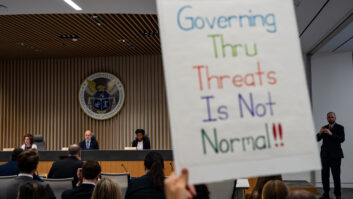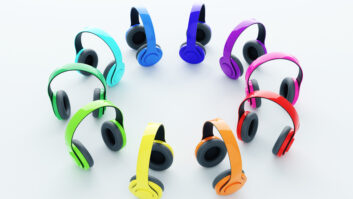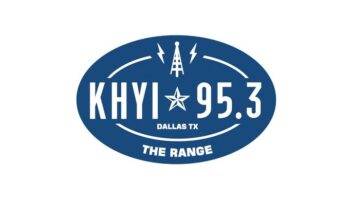This week we’re featuring highlights of 2021’s ebooks.
Pierre Bouvard is chief insights officer at Cumulus Media and its national-facing arm Westwood One. This interview is from “Streaming for Radio in 2021.”
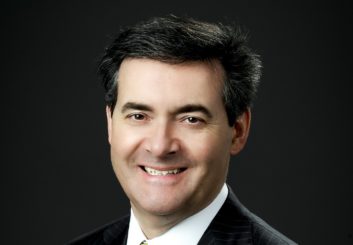 Radio World: How do you think broadcasters are doing at leveraging streaming?
Radio World: How do you think broadcasters are doing at leveraging streaming?
Pierre Bouvard: The real accelerator for streaming has been the smart speaker. Years have gone by since stations started streaming, and it was always maybe 5% of total tuning; the arrival of the smart speaker caused radio stations to really wake up to the fact that the smart speaker brings radio back into the home.
Increasingly, homes do not own a radio, but a third now have smart speakers. Radio stations have been aggressively promoting that “You can listen to our station on your Alexa or Google Home.”
Now 15% of 25-to-54 listening in America occurs through the stream. That’s a substantial number. I think an advertiser needs to understand that if you’re going to spend a dollar on radio, 85 cents can be for the over-the-air and 15 cents should be for the stream.
By the way, we did a study. If you ask the average American, “Do you know how to listen to a radio station on a smart speaker,” there’s still a fair chunk who say no. We need to do a more forceful job of explaining how somebody can use a smart speaker to listen to a radio station.
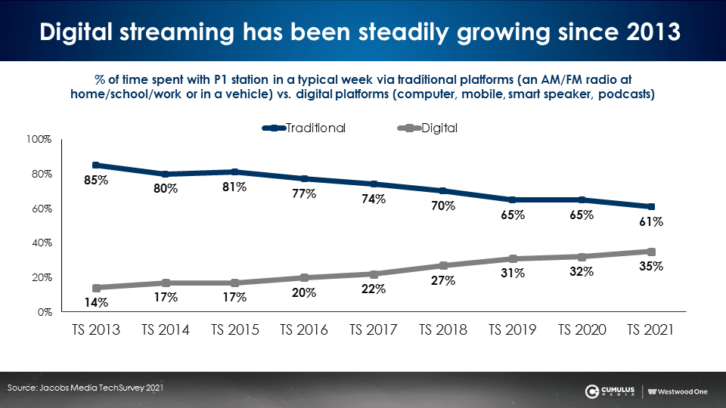
RW: Your Cumulus colleague Doug Hyde blogged recently about some substantial research on streaming.
Bouvard: That is a study done quarterly called “Share of Ear,” conducted by Edison Research. It’s the gold standard study on how Americans consume audio. They have been showing over the last couple of years a steady and persistent increase in the share of listening that’s going to the audio stream.
The second part of this has been Nielsen. Since the Portable People Meter launched in 2010, broadcasters have asked Nielsen, “The PPM does a great job of picking up listening in an ambient fashion in the room, but if I put my headphones in for streaming, how can the PPM pick it up?”
A headphone listening adjustment for streaming went in place October of last year. In essence, streaming listening doubled from 5% to about 10% of 12+ listening.
Broadcasters now have the confidence that Nielsen is picking up streaming; so it can be monetized.
You’ve seen a number of stations doing Total Line Reporting, combining the over-the-air and the stream. The ratings increases when you combine those have been significant; in some markets, especially sports and spoken-word stations, they’re seeing significant increases with the combination of the stream, over-the-air signal and the new headphone adjustment from Nielsen.
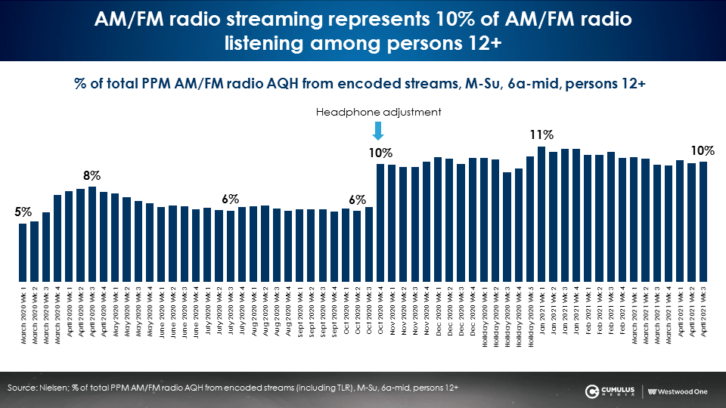
RW: There’s been this common comment that radio managers have struggled to monetize streaming. Has that changed?
Bouvard: When streaming was 5% of radio listening, yes, it seemed like a rounding error. But now that streaming is 15% of adults 25–54, it’s substantial. That is something we’re seeing across the Cumulus platform: Advertisers are seeing the value of the stream.
There’s something else: Streaming is the soundtrack of the American worker.
If you look at the hour-by-hour data, when is streaming strongest? Nine-to-five. This is a workplace audience. It’s one of the most valuable qualitative targets for an advertiser. They have a job. They have incomes.
What you have is a huge amount of audience that’s between the very desirable younger 20s all the way up to the 60s. The audience skews female, which is important for advertisers, since women either control or basically are responsible for most American consumption; and the profile is nicely upscale.
And the majority of the people are from that market. The local advertiser can buy ads in the stream with the confidence that the majority of the people reached are from that town.
RW: Which organizations do you think are incorporating streaming well into their strategies?
Bouvard: Spoken-word radio stations by nature, especially sports stations, have done an extraordinary job. I might have grown up in San Francisco, have allegiances to the San Francisco team; now I’m living somewhere else. Sports has done an amazing job of bringing those out-of-town people back to their hometown teams.
There are certain top personalities who aren’t in every market; streaming is also a way to reach them. We have a podcaster, Dan Bongino. He launched his radio show about two weeks ago. In the press release, we indicated a couple of the stations that would be carrying the show and their stream; the amount of traffic and interest basically crushed our websites and the streaming.
What radio does well is have compelling, funny and entertaining personalities. Streaming is a way for listeners to get to talents that they love even if they’re somewhere where they don’t have access to a radio. When we ask listeners, “What do you like about streaming,” that’s the answer: “It gives me the ability to listen to my favorite radio station, no matter where I am. I like that flexibility.”
That’s the voice of the customer saying, “Give me my station so that I can enjoy it more frequently.” That’s what streaming can do.
RW: What have we learned about analytics, measuring audience and verifying that people are actually hearing this content?
Bouvard: That’s the benefit radio has that Pandora and Spotify don’t. Pandora can tell you, “I delivered a thousand impressions” but you actually don’t know. The ad could have been playing to the empty room. Or the Spotify app could have been played so softly that nobody ever heard it.
The Nielsen Portable People Meter is tuned to the ear; that PPM is only capturing audible signals. We know if the ad was playing at a level that the person could hear.
The other big opportunity is that, by putting the audio stream in a digital format, we can append data to that stream. We can do a study to see: Did the people who heard the radio ad go to the advertiser website? Did the people who heard the radio ad go to the advertiser’s store? Did we grow awareness and interest for the advertiser?
Streaming opens up a whole new world of accountability and measurement.
RW: Sometimes we hear about audio quality and loudness problems, or ads that don’t run, or that you listen to a stream and can tell that no one is paying attention to it. Do you think that remains a problem?
Bouvard: If 15% of radio listening is occurring via the stream, that’s bigger than the entire AM band, which is about 10% of radio listening. That’s significant. When it gets that big, you start paying attention.
It’s like another radio station — we have to give it just as much love and attention. The ads have to run as scheduled. The volume has to be consistent and pleasurable. If we’re going to substitute music, we’re going to need to do that elegantly.
[Check Out More of Radio World’s Ebooks Here]
RW: Do you think our industry has gotten its message to potential advertisers that there’s a benefit over the Pandoras and Spotifys?
Bouvard: Interestingly if you look at the “Share of Ear” data, AM/FM streaming is bigger than Pandora and AM/FM streaming is bigger than Spotify. That speaks for itself.
RW: But is that message getting to the advertising community?
Bouvard: Yes I think it is — thanks to folks like Audacy, who have rebranded and are going to market with a consistent offering. Thanks to iHeart. There are a lot more feet on the streets telling the story of AM/FM streaming.
RW: How you see the role of streaming continuing to evolve?
Bouvard: Jacobs Media runs an annual study called the Techsurvey. Every year they ask listeners, “How do you listen to your favorite radio station? Do you listen over the air, or do you listen with a device like a smart speaker, cell phone, laptop?” If you trend those lines, it has been going up consistently for streaming at the expense of over-the-air. That’s a nine-year trend.
If you keep extrapolating that, there’s going to be a point in time, maybe five years from now, maybe 10, where those lines are going to cross — where half of all American radio listening will be occurring through the stream.
I’m reminded of AM radio. At the beginning of the ’70s, AM dominated and FM was this experimental hippie thing. FM wasn’t in the car. But by 1980, half of all American listening was on FM.
Well, streaming is the new FM. It’s growing, and it’s something to be taken seriously.
Every radio salesperson should be saying, “Every buy on my radio station should have streaming, because it is now getting to be so significant. The audiences are growing so much.”
Every proposal and every buy should have streaming.


